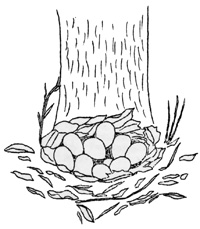

|
|
NATURE NOTES FROM ACADIA
On the thirteenth day of May it was my good fortune to be directed to the nest and eggs of a ruffed grouse which had been discovered in a stand of mixed woods near the Anemone Cave region. Upon approaching to within a few yards of the nest site my companion and I flushed the rusty brown-colored mother bird and soon were looking at twelve buff-colored eggs which were clustered together in a leaf-lined bowl-shaped depression on the ground. I revisited the nest at three or four day intervals thereafter, until eighteen days later, on May 31, I noticed that two of the eggs were slightly cracked. On that day the incubating mother bird ran from the nest when I was only a very few feet away and complained against my intrusion from the nearby woods. The great event was apparently at hand, but on the following day there was no noticeable change. On the afternoon of June 2, twenty days after my first look at the nest, my return was finally rewarded. The mother bird left when I was almost upon her, and a glance explained her unusual state of excitement. In the past twenty-four hours all but one of the eggs had hatched, and the new-born chicks were running in all directions as fast as their weak little legs could carry them. But having no intentions of so disrupting the family I hurriedly left the woods; the parent would soon return to lead her covey from the scene of many disturbances. The ruffed grouse, often referred to as "partridge," lives up to its reptutation as the king of our eastern game birds. It is partial to fairly dense mixed woodland where food and shelter are at hand. As with many other forms of wild life, the ruffed grouse has suffered due to excessive hunting and timber-cutting and today is found scattered throughout its range. A wide variety of vegetable food comprises the diet of this game bird - fruit, seeds, berries and miscellaneous material such as buds, stems, leaves, catkins and blossoms making up 90% or more of the total amount consumed. 
As in the rabbits, there are periodic fluctuations in the numbers of grouse. In the past few years the recovery from their decrease in numbers has been so meager in many sections of the country that certain ornithologists and sportsmen have become alarmed, and a committee has been formed to investigate the causes which might account for the scarcity of the birds. This committee has found the problem a complicated one and reports that "more than a dozen parasites and diseases of varying importance have been noted in the birds." The muffled drumming of the ruffed grouse is a woodland note which belongs to our New England springtime.- Much controversy has waged as to how the sound was produced, but photographs made of the drumming birds lead ornithologists to the statement that it is the result of the wings striking the air alone. - Ranger-Naturalist |
| <<< Previous | > Cover < | Next >>> |
nature_notes/acad/vol2-2e.htm
09-Jan-2006